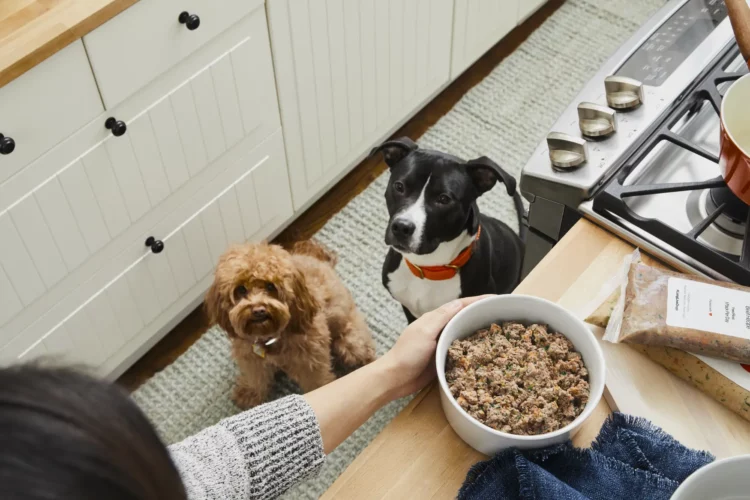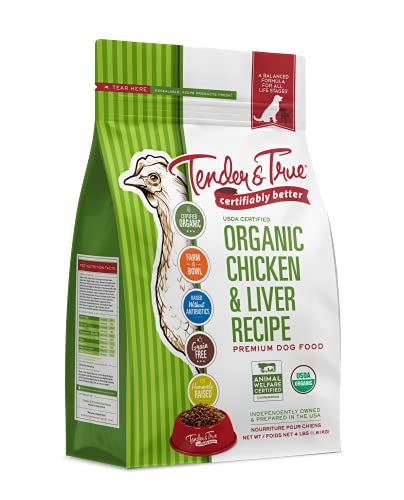As pet parents, you probably spend a lot of time thinking about the food your dog eats: What are the best organic dog foods? Which brands offer the best nutrition? What flavors does your pup like the best? Which foods offer the best cost-value balance? From natural dog foods to organic pet food delivery services; then there are grain-free options, wholesome and holistic offerings, and high-protein dog foods – both as dried kibble and canned wet food – there are plenty of options for you to evaluate. Finding the right natural or organic dog food for your pet means reading reviews, studying ingredients lists, and diving into the ins and outs of natural vs. grain-free vs. organic dog foods.
If you are interested in seeing some other food or treat options for your pets, make sure to check out our pet food and treats articles.
We reviewed dozens of organic and natural dog food brands to find the best of the best, based on Amazon reviews, quality of ingredients, cost, and other considerations. We narrowed our search down to 5 of the top-rated natural and organic dog foods pet parents can purchase to ensure a healthy diet for their dog.
We’ve identified Organix Organic Canned Adult Dog Food as the best bet. Boasting the highest quality ingredients and no added hormones or antibiotics, this organic dog food will provide your dog with the essential nutrients they need for their health.
The 5 Top-Rated Organic Dog Foods
| Editor’s Picks | Brand | Rating |
|---|---|---|
| Best Organic Dog Food Overall | Organix Organic Canned Adult Dog Food |
4.2 |
| Best Organic Chicken Dog Food | Organix Dry Dog Food Organic Chicken & Sweet Potato Recipe | 4.7 |
| Best Budget Organic Dog Food | Tender & True Organic Chicken & Liver Recipe Dog Food | 4.3 |
| Best Organic Dog Food for Small Breeds | Organix Small Breed Recipe Dry Dog Food | 4.3 |
| Best Organic Vegetable Dog Food | Nummy Tum Tum Pure Pumpkin For Pets | 4.6 |
*Ratings are from Amazon at the time of publication and can change
Best Organic Dog Food Overall: Organix Organic Canned Adult Dog Food
Organix Organic Canned Adult Dog Food is our pick of all of the organic dog foods on the market for a multitude of reason. The USDA certified organic food also guarantees no GMOs, so if you’re strict on the certifications your dog food has – this is the one for you. As the manufacturer says, “The potential benefits of an organic diet for your dog or cat include a reduction of allergies and itchy skin, reduced digestion problems, and better health overall.”
You can also be sure that this food has none of the extras that may be bad for your pooch. No added hormones or antibiotics, no artificial preservatives or chemical pesticides; only ingredients you wouldn’t mind eating yourself. It comes in a variety of different flavors and each one lists the number one ingredient as meat (either chicken or turkey). The remaining ingredients are vegetables and/or brown rice and other super foods that will make sure your dog is getting optimum nutrition.
One thing you may consider worthy of note is the layer of fat that often hardens on the top of the can. Not only is this something you shouldn’t worry about, it’s a sign of “real food” ingredients. When you pull your leftover pot roast from the refrigerator you see the same layer and for the same reason: Fat hardens when it cools. You can stir it enthusiastically or warm it a bit before serving and your dog will lap it right up.
Organix Organic Canned Adult Dog Food Key Features:
- USDA certified organic ingredients, formulated with essential vitamins and minerals
- No chemicals, chemical pesticides, hormones or antibiotics
- Variety of flavors
- Product of the USA
Best Organic Chicken Dog Food: Organix Dry Dog Food Organic Chicken & Sweet Potato Recipe
Organix Dry Dog Food Organic Chicken & Sweet Potato Recipe doesn’t mess around when it comes to high-quality, organic ingredients. The number one ingredient is responsibly-raised, organic, and free-range chicken, which is precisely what you’d want in an organic chicken dog food recipe!
Other organic ingredients you’ll find in this recipe include plenty of superfoods such as organic flaxseed, blueberries, and coconut oil. It’s worth keeping in mind that many brands try to get away with labeling their food “organic” even though the formula only contains a minuscule amount of organic ingredients.
In addition to being organic, the recipe is formulated to be free of GMOS, corn, soy, wheat, chickpeas, and lentils. This makes it a fantastic choice for dogs with allergies or with sensitive stomachs.
Organix Dry Dog Food Organic Chicken & Sweet Potato Recipe Key Features
- Responsibly-raised, organic, and free-range chicken
- Organic superfoods
- GMO-free
- 3 sizes available
Best Budget Organic Dog Food: Tender & True Organic Chicken & Liver Recipe Dog Food
There’s no getting around the fact that organic dog foods are generally priced higher than their non-organic counterparts. If you’re after a relatively affordable organic option both you and you dog will love, we recommend trying Tender & True Organic Chicken & Liver Recipe Dog Food. At $0.27 per ounce for a 4 pound bag, it’s far cheaper than many equivalent options. You can save even more by opting for a larger size.
This budget-friendly kibble is not only USDA certified organic, but it’s also completely free of grains, soy, wheat, and corn. The number one ingredient in this delicious organic chicken and liver recipe is cage-free organic chicken. In fact, the chicken used in the recipe is third-party certified to be humanely-raised. As you can tell, there’s a lot to love about this option!
Tender & True Organic Chicken & Liver Recipe Dog Food Key Features:
- $0.27 per ounce
- Cage-free organic chicken
- Grain free
- Prepared in the USA
Best Organic Dog Food for Small Breeds: Organix Small Breed Recipe Dry Dog Food
Let your dog indulge with Organix Small Breed Recipe Dry Dog Food by satisfying his appetite for real meat, with no grains, gluten or fillers. This organic dog food is made from USDA-certified organic, free-range chicken.
The meat is sourced in the USA and freeze dried raw, providing him as close to an ancestral meal as you can pick up in the dog food aisle. This may even be better, because you can ensure the meat he’s consuming comes from meat raised organically and produced naturally. The recipe is packed with a dog superfood blend of organic flaxseed, organic blueberries, and organic coconut oil.
Because the food is packed with nutrients and taste, you can even use each of these bits as individual treats, if you so choose. You can, of course, serve it as a standalone meal, or mix into your pup’s favorite kibble.
Organix Small Breed Recipe Dry Dog Food Key Features:
- 6 Available Flavors
- 100% free-range and organic. Made with probiotics and prebiotic fiber
- No artificial preservatives, chemical pesticides, fillers, grains, colorings, or added growth hormones or antibiotics
- Made in an organically certified kitchen in the USA
Best Organic Vegetable Dog Food: Nummy Tum Tum Pure Pumpkin For Pets
We recommend Nummy Tum Tum Pure Pumpkin For Pets with full confidence if you’re after an vegetable-based organic dog food for your pooch. In fact, this fiber-rich food only contains a total of one ingredient: 100% pure and USDA Organic pumpkin sourced from local farms.
It’s important to keep in mind that this food shouldn’t make up the bulk of your dog’s diet as it’s formulated for intermittent or supplemental feeding. The manufacturers recommend adding 1 tablespoon daily per 10 lbs. weight of dry food. You can use it as a daily food supplement, special treat, or digestive aid. Since it’s low-calorie, very flavorful, and high in fiber, it also makes the perfect addition to a weight-management dog diet.
In each order, a total of 12 x 15 oz. cans, all of which boast a BPA-free liner. In terms of feedback, Nummy Tum Tum Pure Pumpkin For Pets has an impressive rating of 4.6 on Amazon.
Nummy Tum Tum Pure Pumpkin For Pets Key Features:
- 100% pure and USDA Organic
- Sourced from local farms
- 12 x 15 oz. cans
- Made in the USA
Who Should Buy Organic Dog Food?
If you buy organic food for yourself then you very likely already know the answer to why a person should feed their dog organic. In 2013, Ria Chhabra did a middle school Science Fair project where she compared the effects of fruit flies eating an all organic diet to fruit flies eating non-organic foods of the same type. The NY Times wrote an article on her findings in 2013 claiming, “By nearly every measure, including fertility, stress resistance and longevity, flies that fed on organic bananas and potatoes fared better than those who dined on conventionally raised produce.”
You should note, however, that the label of “Organic” does not necessarily make your dog’s food healthier. There is organic candy, after all. You can have organic sugars and fruits and even organic grains that are disproportionate to the meat in your dog food. You should still look at the ingredients to make sure that what you’re feeding your dog is healthy. You can feed your dog a healthy diet without it being organic and you can feed your dog an organic food and it still be incredibly unhealthy.
Important Features to Consider
Not all natural or organic dog foods are created equal. Here’s what to consider when evaluating the options in search of the best natural or organic diet for your pet:
- Organic vs. natural. When dealing with dog food, ‘Natural’ and ‘Organic’ are often used in conjunction, but not always. The term ‘Natural’ generally means the meat was produced naturally, without any artificial ingredients; usually coloring, flavors, sweeteners or preservatives. But ‘Natural’ doesn’t apply to the way the meat was produced; so the cows or chickens could have been fed hormones or antibiotics. ‘Organic’ refers to the way the meat was produced and the end result; meaning they must be fed an all organic diet and have a higher standard of living conditions.
- Grain-free vs. gluten-free. It’s important to note that gluten-free isn’t the same as grain-free, so if for some reason you suspect your dog has an allergy to grains, you’ll need to look a bit deeper than just a gluten-free dog food. There are types of grain that do not contain gluten and therefore you can get a gluten-free dog food that still contains grains. If you’re trying to avoid any “filler” ingredients and you think grain may be that for your dog, look out for the common “gluten-free grains,” including quinoa, amaranth and buckwheat.
- Select organic ingredients vs. all-organic. Once you’ve determined that the way the food was raised is important to you, you’ll need to look even closer at that label. If the label reads “USDA Organic” the contents are at least 95% organic as is recognized by the USDA. The dog food that declares it is “Made with Organic Ingredients,” at least 70% of the ingredients meet the criteria for the USDA’s organic standards.
- Non-generics. We don’t mean “name brand” when we write ‘generic;’ we mean in the ingredient list. You’ll want to stick to ingredients that give specifics. Avoid the “Meat protein,” “Animal By products” or “Animal Fat” and look for the animal and meat to be named specifically. The same will go for any ingredient. If it’s not named it could very well be a combination of otherwise unusable food. There’s a parallel between this and the meat that goes into a hot dog; except for dog food the standard is much lower than for human food.
- Recognizable ingredients. Ideally, you should be able to recognize the bulk of your dog food’s ingredients. There are very likely minerals, vitamins and preservatives you won’t recognize but your pup may benefit by you familiarizing yourself with these so you can identify unwanted ingredients. Ingredient lists put what they contain the most of first so you want to look for a dog food that lists ingredients you recognize in the first handful of ingredients.
- Recalls. Some ingredients have had mandatory recalls and others have had voluntary recalls. You may want to smarten up on past recalls to make sure you’re not getting a dog food that has ingredients other brands have voluntarily recalled. For example, recently a leading dog food manufacturer voluntarily recalled a number of its products after finding Pentobarbital within them. Pentobarbital is used in significantly greater doses to induce euthanasia on pets and therefore, probably not something you’d want to give your pooch. The FDA provides an updated list of pet food recalls for easy reference here, and the American Veterinary Medical Association maintains a list here. Another helpful resource for keeping an eye on dog food recalls is Dog Food Advisor.
- Price point. At some point, you may find it’s simply less expensive to make your own dog food so you can better control the quality and freshness. But you will need to consider the time that goes into making these foods at home. Your time does equal money so don’t bite off more than you can chew or more than is financially worth it to you.
- Regulations and certifications. The FDA is the primary source that regulates dog food and each state has a Department of Agriculture that has a secondary authority over pet food; both of these agencies regulate but do not always enforce. The USDA and the AAFCO have no regulatory authority but have voluntary inspections in place to gain food certification. If it’s certified, you’ll see it very clearly on the label. Note, though not all dog foods are certified, the certification process is often pricey and some companies just opt not to go through that. And very often it’s just the ingredients that are certified. So it will say, for example, “Made with USDA beef” but the dog food itself isn’t certified.
Frequently Asked Questions
Are grain-free dog foods better?
Can you give raw meat to a dog?
If you choose to purchase raw pet food, you’ll have to worry substantially less (but keep in mind you will still need to keep an eye on your dog’s response to the raw food diet). Dog Food Manufacturers need to adhere to FDA suggested regulations, but remember, no matter how strictly they adhere to those regulations, raw food comes with a certain amount of risk of bacterial infections.
What is the healthiest food to feed your dog?
If you’re looking to buy a healthy dog food, we have some recommendations on brands but if you’re looking independently, you’ll want to look through ingredient lists to find a specific animal protein at the top of the list, whole vegetables fruits and grains and a protein meal combined with any fresh or frozen protein. Fresh and frozen contain up to 75% water, so combining it with a protein meal (which is only 10% water) will get you the most bang for your buck.
What is dog food made out of?
Before you buy a dog food, take a look at the ingredients list; there are a few things you can keep in mind to help you decipher the quality of your dog’s food. The less expensive brands are generally poorer quality and higher priced are higher quality. But there are other factors to keep in mind. For example, if your dog food doesn’t list meat as it’s first ingredient, that’s usually a bad sign. Unspecified meat is another indicator that the quality isn’t especially high; that is, “Animal” or “Meat” instead of “Chicken” or “Beef.” You’ll also want to look for artificial flavoring, colors, and some preservatives. (Natural preservatives don’t preserve foods as long as the artificial ones, so always check your ‘best by’ dates.) Added sweeteners are often used to mask the taste of a primarily grain food so the dog will still eat it, despite it’s lack of protein.
Wet dog food is higher in moisture and often necessary for dogs with sore mouths or missing teeth. The recipes for wet dog foods are typically higher in protein and fat than the recipes for dry dog foods, but because it’s already wet, more will need to be consumed for proper nutrition. You will still need to make sure there is a decent meat to grain ratio, though, because often the protein gels will form meat-like chunks that give the illusion of more meat than is actually present.




















